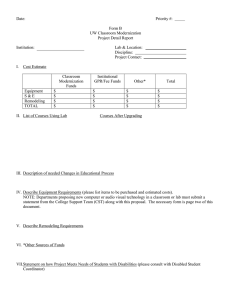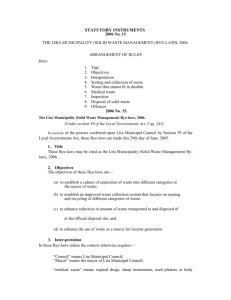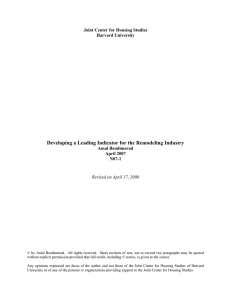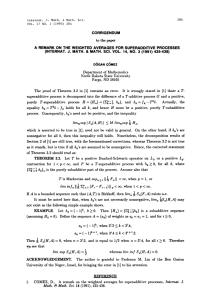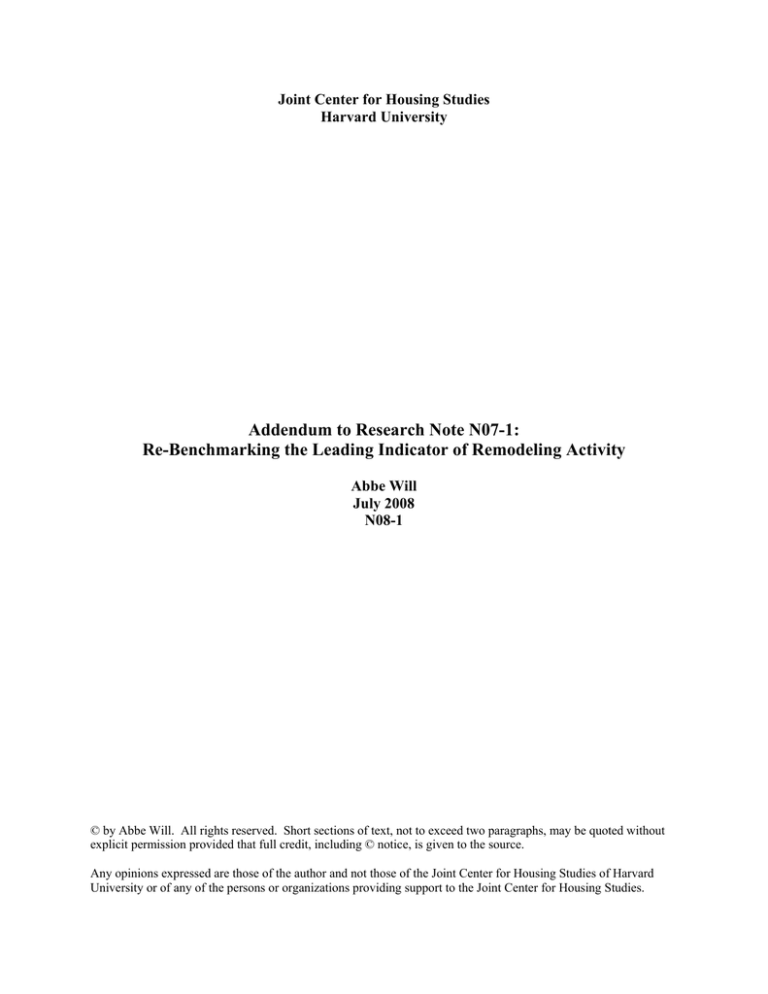
Joint Center for Housing Studies
Harvard University
Addendum to Research Note N07-1:
Re-Benchmarking the Leading Indicator of Remodeling Activity
Abbe Will
July 2008
N08-1
© by Abbe Will. All rights reserved. Short sections of text, not to exceed two paragraphs, may be quoted without
explicit permission provided that full credit, including © notice, is given to the source.
Any opinions expressed are those of the author and not those of the Joint Center for Housing Studies of Harvard
University or of any of the persons or organizations providing support to the Joint Center for Housing Studies.
Introduction
This addendum to Research Note N07-1 provides an explanation of new changes to the
benchmarked data series for the Joint Center for Housing Studies’ Leading Indicator of
Remodeling Activity (LIRA).1 These changes were necessitated by the recent discontinuation of
the U.S. Census Bureau’s Survey of Residential Alteration and Repairs and consequently the
Bureau’s publication of the quarterly Residential Improvements and Repairs Statistics (C-50).
Not only did the C-50 serve as the historical reference series for the LIRA estimates, it was also
an integral part of the weighting methodology and estimation of the LIRA model. Fortunately, a
fairly comparable substitute for the C-50 data was found in the Bureau’s Construction Spending
statistics, also known as the C-30 series. However, the C-30 only provides estimates of
homeowner improvement spending, whereas the C-50 estimated both improvements and
maintenance and repairs to owner-occupied units, as well as rental units. Consequently, the
major difference between the former and re-benchmarked LIRA is that the former LIRA
provided estimates of trends in homeowner improvements and maintenance and repair spending,
while the re-benchmarked LIRA only tracks changes in owner improvement expenditures.
The home remodeling industry is closing in on $300 billion a year in improvement and
repair expenditures, yet this industry continues to struggle for timely and consistent data on current
market size estimates and trends.2 Although the C-50 was designed to measure national
expenditures for residential improvements and repairs on a quarterly basis, the estimates exhibited
unusual volatility and inconsistency and were subjected to numerous revisions through the years
including a change of survey methodology. To further exasperate the industry’s desire for quality
data, the release of C-50 estimates lagged the reference period by fully four months. Recognizing
the need for more timely and accurate assessments of the industry, the Joint Center’s Remodeling
Futures Program developed the Remodeling Activity Indicator (RAI) in 1998.3 Released only two
weeks after the end of the reference period, the RAI provided the industry with much timelier
estimates of current changes in homeowner remodeling activity at the national level. While the
1
See Amal Bendimerad, “Developing a Leading Indicator for the Remodeling Industry,” Joint Center for Housing
Studies of Harvard University, Research Note N07-1, April 2007.
2
For historical market size estimates see “Foundations for Future Growth in the Remodeling Industry,” Improving
America’s Housing 2007, Joint Center for Housing Studies of Harvard University.
3
See Alvaro Martin-Guerrero, “An Improved Method for Estimating Homeowner Improvement and Repair Activity
Through Revisions to the Remodeling Activity Indicator,” Joint Center for Housing Studies of Harvard University,
Working Paper W04-4, April 2004.
1
RAI helped the industry measure current remodeling activity, the industry still lacked a forwardlooking indicator that could project market size and trends in the near-term.
In April 2007, the Remodeling Futures Program replaced the RAI with the LIRA. The
LIRA not only provided estimates of current homeowner improvement and repair activity, but it
also provided a short-term projection of remodeling activity with a horizon of three quarters.
The significant difference between the RAI and the LIRA is that, as a leading indicator, the
LIRA is intended to signal major turning points in the remodeling cycle in the near future. Like
the RAI, the LIRA is constructed as a composite measure of several economic indicators that
tend to impact remodeling activity levels. Also, both the RAI and the LIRA used the C-50’s
measure of homeowner improvements and maintenance and repair spending as a point of
reference in producing near-term estimates of quarterly expenditure levels. With the release of
the final C-50 estimate in May 2008, the continuation of the LIRA depended on rebenchmarking to an alternative source of national remodeling estimates.
LIRA Methodology and Performance Against the C-50
The LIRA is computed as a moving four-quarter rate of change of its weighted
components. A four-quarter, or annual, rate of change is the ratio that results when the total
activity in any given four-quarter period is divided by the total activity that occurred in the prior
four quarters. This calculation results in a rate of change that measures annual (year-over-year)
changes in activity levels on a quarterly basis. The final inputs of the LIRA were determined by
the magnitude and strength of their correlations with the C-50’s measure of homeowner
improvements and maintenance and repair expenditures. Input series with strong and highly
significant correlation coefficients received greater weight, while inputs with high variability (as
measured by the standard deviation) received lesser weight. To be exact, inputs with strong
correlation to the C-50, but low variation received the greatest weight, while those with weaker
correlation and higher variation received the least weight in calculating the LIRA rate of change.
When benchmarked to the C-50, the LIRA produced an annual rate of change in
homeowner improvement and repair spending. Again, the LIRA was designed to produce more
stable projections of market size trends that better reflect actual changes in remodeling activity
than those produced by the C-50. While the remodeling industry is cyclical with alternating
periods of growth and decline, the highly erratic fluctuations found in the quarterly C-50
2
estimates pointed toward data quality problems rather than real changes in activity. Figure 1
shows how the LIRA estimates compared to the C-50 historically, and confirms that the LIRA
produces much smoother estimates of industry trends, while still following the same general
pattern of upturn and downturn.
Figure 1: LIRA Closely Tracked General Trends in C-50, Yet Much More Stable
Four-Quarter Moving Rate of Change in Annual Expenditures for Homeowner Improvements and Repairs
25%
20%
15%
10%
5%
0%
-5%
-10%
C-50 Owner Improvements & Repairs
07-Q3
07-Q1
06-Q3
06-Q1
05-Q3
05-Q1
04-Q3
04-Q1
03-Q3
03-Q1
02-Q3
02-Q1
01-Q3
01-Q1
00-Q3
00-Q1
99-Q3
99-Q1
98-Q3
98-Q1
97-Q3
97-Q1
96-Q3
96-Q1
95-Q3
95-Q1
-15%
LIRA
Source: Joint Center for Housing Studies and U.S. Census Bureau's Residential Improvements and Repairs Statistics (C-50).
Replacing of the C-50 as the LIRA Benchmark
Due to the many challenges of reliable data collection, few sources exist that provide
frequent and direct measures of national remodeling expenditures. While the Department of
Housing and Urban Development’s American Housing Survey (AHS) covers homeowner
improvement spending in great detail, the AHS is only conducted once every two years. Other
government surveys are conducted much more frequently, but they are not designed to
specifically collect data on remodeling expenditures. For example, the Bureau of Labor
Statistics’ Consumer Expenditure Survey (CE) is conducted quarterly and is designed to collect
detailed information on the buying habits of American consumers, including expenditures for
home improvements and repairs. However, the CE has a relatively small sample of
approximately 7,000 households per quarter, which is not optimal for capturing data on large and
3
infrequent expenditures, such as home improvements. Nevertheless, beginning in the mid 1980s
the Census Bureau began incorporating data from the CE on homeowner improvement and repair
spending into the C-50 estimates as a means of eliminating data collection redundancies. The
same improvements (but not maintenance and repairs) data from the CE has also been
incorporated into the Census Bureau’s Value of Private Construction Put in Place (C-30), making
this component of the C-30 a comparable replacement for the C-50.4
The homeowner improvement estimates from the CE data are embedded in the monthly
estimates of total private residential construction spending in the C-30. That is, the improvement
numbers are not a published line item in the report, but rather are included in the total. By
subtracting the values of new single family and new multi-family construction, the remainder is
the value of improvements to owner-occupied units (both single and multi-family). Since both
the C-50 and C-30 used owner improvements data from the same survey, one would expect the
two series to match perfectly. Yet, as seen in Table 1, the C-50 and C-30 estimates only equal on
an annual basis, but vary somewhat by quarter. The relatively small differences from quarter to
quarter are due to various smoothing and benchmarking routines run by the Census Bureau as are
required to create a monthly series from the quarterly CE survey data. Also, while the C-30
reports data with only a one month lag, the embedded estimates of improvements are based on
incomplete survey data for a period of five months after first release and are subject to
substantial revisions until data collection and reporting is complete.5
A comparison of the four-quarter moving rates of change in the C-50 estimates of
homeowner improvement and repair spending and the C-30 estimates of owner improvement
expenditures shows that the C-30 estimates are much smoother than the C-50, but also
considerably more cyclical (see Figure 2). This increased cyclicality is expected since
discretionary improvement spending tends to be more volatile compared to the more routine and
less costly expense of maintenance and repairs.
4
See http://www.census.gov/const/www/c30index.html for the U.S. Census Bureau’s Construction Spending
reports.
5
In this way, improvement estimates based on complete survey data are first used in the May publication for
revisions to the previous year. See http://www.census.gov/const/C30/methodology.pdf for a full description of the
methodology for collecting and reporting improvements to owner-occupied units in the C-30.
4
Figure 2: Annual Movement in C-30 is Less Erratic, But More Cyclical Than C-50
Four-Quarter Moving Rate of Change in Annual Homeowner Remodeling Expenditures
25%
20%
15%
10%
5%
0%
-5%
-10%
C-50 Owner Improvements & Repairs
07-Q3
07-Q1
06-Q3
06-Q1
05-Q3
05-Q1
04-Q3
04-Q1
03-Q3
03-Q1
02-Q3
02-Q1
01-Q3
01-Q1
00-Q3
00-Q1
99-Q3
99-Q1
98-Q3
98-Q1
97-Q3
97-Q1
96-Q3
96-Q1
95-Q3
95-Q1
-15%
C-30 Owner Improvements
Source: JCHS tabulations of U.S. Census Bureau's Residential Improvements and Repairs Statistics (C-50) and Value of Private Residential Construction Put in Place (C-30).
5
Table 1: Comparison of Homeowner Improvement Expenditure
Estimates in U.S. Census Bureau's C-30 and C-50 Series
1993 Total
Q1
Q2
Q3
Q4
1994 Total
Q1
Q2
Q3
Q4
1995 Total
Q1
Q2
Q3
Q4
1996 Total
Q1
Q2
Q3
Q4
1997 Total
Q1
Q2
Q3
Q4
1998 Total
Q1
Q2
Q3
Q4
1999 Total
Q1
Q2
Q3
Q4
2000 Total
Q1
Q2
Q3
Q4
6
Homeowner Improvements ($Bil, NSA)
C-30
C-50
57.3
57.3
9.8
10.2
15.3
14.9
17.3
16.7
14.9
15.4
64.6
64.6
13.1
11.9
18.5
20.6
18.7
17.0
14.3
15.1
56.7
56.7
11.6
10.7
16.0
17.8
16.2
16.7
12.9
11.6
66.4
66.4
11.9
13.0
18.7
16.6
20.0
20.2
15.8
16.6
66.6
66.6
12.7
12.7
18.5
17.6
19.1
19.8
16.3
16.5
72.4
72.4
14.0
13.7
21.4
23.6
20.6
18.3
16.4
16.8
75.0
75.0
12.4
12.9
20.3
19.5
21.7
21.5
20.6
21.2
81.1
81.1
15.8
14.5
23.2
21.6
22.2
22.4
19.8
22.6
Difference
from C-50
0.0
-0.4
0.4
0.5
-0.5
0.0
1.2
-2.1
1.7
-0.8
0.0
0.9
-1.8
-0.5
1.4
0.0
-1.0
2.1
-0.2
-0.8
0.0
0.0
0.9
-0.6
-0.2
0.0
0.3
-2.2
2.3
-0.3
0.0
-0.5
0.8
0.2
-0.5
0.0
1.3
1.6
-0.2
-2.7
Table 1 Cont.: Comparison of Homeowner Improvement Expenditure
Estimates in U.S. Census Bureau's C-30 and C-50 Series
2001 Total
Q1
Q2
Q3
Q4
2002 Total
Q1
Q2
Q3
Q4
2003 Total
Q1
Q2
Q3
Q4
2004 Total
Q1
Q2
Q3
Q4
2005 Total
Q1
Q2
Q3
Q4
2006 Total
Q1
Q2
Q3
Q4
2007 Total
Q1
Q2
Q3
Q4
Homeowner Improvements ($Bil, NSA)
C-30
C-50
85.0
85.0
15.1
14.7
23.5
25.4
24.3
25.1
22.1
19.8
97.9
97.9
18.2
18.7
28.1
27.8
29.1
28.1
22.4
23.2
100.3
100.3
17.0
18.0
26.1
28.7
31.1
30.9
26.1
22.7
115.4
115.4
21.2
21.2
29.7
29.2
35.7
34.5
28.8
30.6
131.1
131.1
23.5
24.3
32.6
30.8
40.8
40.0
34.2
36.0
144.9
144.9
28.9
28.7
37.9
38.8
43.4
43.1
34.7
34.3
139.1
139.1
30.0
28.9
39.2
37.2
40.4
37.3
29.4
35.7
Source:
Census Bureau, Value of
Construction Put in Place
Census Bureau,
Expenditures for Residential
Improvements and Repairs
Native Frequency:
Monthly
Quarterly
Difference
from C-50
0.0
0.4
-1.9
-0.8
2.3
0.0
-0.5
0.2
1.0
-0.8
0.0
-1.0
-2.6
0.2
3.4
0.0
0.0
0.5
1.2
-1.7
0.0
-0.8
1.8
0.8
-1.8
0.0
0.2
-1.0
0.3
0.5
0.0
1.2
2.1
3.1
-6.3
7
Re-benchmarking the LIRA to the C-30
The same procedures were followed in re-benchmarking the LIRA to the C-30 estimates
of homeowner improvement spending as were used when the C-50 was the reference series. A
variety of economic indicators that are thought to influence remodeling spending were identified
and tested for correlation with the C-30 at various leads (in quarters) over C-30 spending.6 As
expected, many of the indicators previously included in the LIRA also exhibited strong
correlation with the C-30. However, several inputs that previously correlated well with the C-50
had a much weaker association to the C-30. These indicators were thus dropped from the LIRA,
including Hours Worked by Remodelers and ECRI’s Weekly Leading Index.7 New additions to
the LIRA include the Number of Employees of at Residential Remodeling Establishments,
Single Family Housing Starts, and 30-Year Treasury Bond Yields. A complete description of the
final input variables used to compute the re-benchmarked LIRA is found in Table 2.
The correlation results and associated lead times for the final inputs, including
significance levels, are found in Table 3. A simple correlation between the four-quarter rates of
change in each indicator and the rates of change in homeowner improvements was calculated at
varying lead times over a relatively short time period from the second quarter of 2001 to the
fourth quarter of 2007. The reason for the short time frame is because poorly documented
revisions were made to the owner improvement estimates in early 1999, which indicates that data
from the more recent time period may not be completely comparable to the data from before
1999. Since the calculation of the four-quarter rates of change includes eight quarters worth of
data, the first annual rate of change to not include data from the first half of 1999 is that of the
second quarter of 2001. For each input, the lead time that produced the highest correlation with
the C-30 is outlined in the table, with two exceptions. In the case of Housing Starts and the
Remodeling Market Index, some discretion was used to trade a slightly better correlation with
the C-30 for a greater lead time.
6
See Appendix Table A1 for the four-quarter moving rates of change from 1995 to 2007 for each input variable
included in the re-benchmarked LIRA.
7
The Improvements input previously included in the LIRA was essentially the same as the C-30 estimates now used
as a benchmark. Also, the Cash-Out Refinancing input was previously removed from the LIRA when Freddie Mac
discontinued the publishing of quarterly forecasts in late 2007.
8
Table 2: Description of Final Input Variables for LIRA
Data Series
Purchasing Managers'
Index (PMI)
Number of Employees at
Residential Remodeling
Establishments
Mnemonic
ISM
Lead
Time*
0
Definition
Composite index based on the diffusion index of five
indicators: New Orders, Production, Employment, Supplier
Deliveries and Inventories; 50+ = Expansion in
manufacturing activity.
Total payroll employment in residential remodeling
industry, including remodeling general contractors,
operative remodelers, remodeling design-build firms, and
remodeling project construction management firms.
Manufacturers' shipments of Construction Materials and
Supplies, Wood Products, and Household Appliances.
Bureau of Labor
Statistics
0
U.S. Census Bureau,
Manufacturers'
Shipments, Inventories
and Orders (M3)
0
Department of
Commerce
U.S. Census Bureau
1
Retail Sales at Building Materials and Supplies Dealers.
3
New privately-owned 1-unit housing starts.
RMI
National Association of
Home Builders
4
Average of four indices: Call For Bids, Amount of Work
Committed for the Next 3 Months, Backlog of Remodeling
Jobs, and Appointments for Proposal; 50+ = Remodelers
view remodeling conditions as higher than the previous
quarter.
Pending Home Sales
Index
PHSI
National Association of
Realtors
4
Index based on signed real estate contracts for existing
single-family homes, condos and co-ops; A signed
contract is not counted as a sale until the transaction
closes.
30-Year Treasury Bonds
Yield
Bond
Federal Reserve Board
4
30-Year Treasury Bond Yield at Constant Maturity (%
p.a.)
Shipments of Building
Materials
Retail Sales of Building
Materials
Single Family Housing
Starts
Remodeling Market
Index, Future
Expectations
Labor
Source
Institute of Supply
Management
Shipmts
Retail
Starts
* Refers to lead over C-30 spending in quarters
9
Table 3: Correlation Coefficients with C-30 Owner Improvements, 2001Q2 to 2007Q4
t(0)
t(1)
t(2)
t(3)
t(4)
Obs
Std. Dev
Mean
Min
Max
ISM
0.543
0.004
0.375
0.054
0.061
0.762
-0.217
0.277
-0.294
0.137
Labor
0.441
0.022
0.184
0.357
-0.052
0.798
-0.177
0.377
-0.200
0.317
Shipmts
0.664
0.000
0.591
0.001
0.399
0.039
0.171
0.395
-0.004
0.983
Retail
0.735
0.000
0.786
0.000
0.673
0.000
0.411
0.033
0.090
0.655
Starts
0.465
0.014
0.609
0.001
0.692
0.000
0.686
0.000
0.571
0.002
RMI
-0.004
0.988
0.286
0.221
0.493
0.032
0.562
0.015
0.537
0.026
PHSI
0.457
0.037
0.585
0.007
0.688
0.001
0.772
0.000
0.835
0.000
Bond*
-0.173
0.389
0.058
0.773
0.416
0.031
0.672
0.000
0.672
0.000
27
0.103
1.029
0.842
1.224
27
0.043
1.063
0.973
1.113
27
0.050
1.018
0.940
1.088
27
0.050
1.064
0.964
1.141
27
0.129
1.028
0.734
1.169
21
0.078
1.012
0.907
1.187
21
0.089
1.035
0.885
1.156
27
0.054
0.972
0.888
1.082
*The correlations for Treasury Bond yields were calculated using inverse yield rates since a decline in yield rates is
correlated with an increase in improvement spending.
Note: The significance level of each correlation coefficient is reported in the line below the coefficient as a p-value
indicating the level of confidence that the correlation is not equal to zero.
The next step in re-benchmarking the LIRA involves the calculation of the input weights.
Again, inputs with higher correlations to the C-30 and lower standard deviations will have
greater weight in calculating the final LIRA estimates. The final weight calculations are
described in Table 4. With both very low variation and high correlation, Retail Sales of Building
Materials has the highest weight of the final eight indicators at 15.7% followed by Shipments of
Building Materials, Bond Yields, and Number of Remodeling Employees.
10
Table 4: Calculation of LIRA Weights Using Input Correlations with C-30 Improvements from 2001Q22007Q4
ISM
Labor
Shipmts
Retail
Starts
RMI
PHSI
Bond
0
0
0
1
3
4
4
4
0.103
0.043
0.050
0.050
0.129
0.078
0.089
0.054
9.75
23.31
20.10
19.94
7.78
12.76
11.28
18.39
8%
19%
16%
16%
6%
10%
9%
15%
0.543
0.441
0.664
0.786
0.686
0.537
0.835
0.672
Share of sum of Correlation
11%
9%
13%
15%
13%
10%
16%
13%
Final LIRA Weights
9.2%
13.7%
14.6%
15.7%
9.8%
10.4%
12.7%
14.0%
Lead over C-30 (number of quarters)
Standard Deviation
1/STD
Share of sum of 1/STD
Correlation w/ C-30
As seen in Figure 3, the re-benchmarked LIRA closely follows the same trends in
remodeling activity as the C-30 and anticipates turning points well. While the C-30 is
considerably less erratic from quarter to quarter compared to the C-50, the LIRA is still much
less volatile than the C-30. Where the standard deviation of the annual growth in the C-30
between 1995 and 2007 is 0.078, the standard deviation of the LIRA is only 0.048. The
correlation between the C-30 and the re-benchmarked LIRA is 0.792 over the more current
reference period between 2001 and 2007 (the same time period from which the input correlations
and weights are drawn). An adjusted R2 value of 0.6120 suggests that the eight LIRA inputs
explain over 60% of the variation in the C-30’s estimates of homeowner improvement spending.
Finally, a comparison of the LIRA estimates produced from benchmarking to the C-50
and the LIRA estimates resulting from benchmarking to the C-30 shows that both procedures
produce very similar trends in annual growth in their respective markets, but the re-benchmarked
LIRA estimates stronger year-over-year declines in the improvements market than were
previously estimated for the improvements and repairs market (see Figure 4). Again, this finding
is not surprising since the improvements market is typically more cyclical than the overall
market for both improvements and repairs.
11
Figure 3: Re-Benchmarked LIRA Smoothes Volatility of C-30
Four-Quarter Moving Rate of Change in Annual Expenditures for Homeowner Improvements
25%
20%
15%
10%
5%
0%
-5%
-10%
C-30 Owner Improvements
07-Q3
07-Q1
06-Q3
06-Q1
05-Q3
05-Q1
04-Q3
04-Q1
03-Q3
03-Q1
02-Q3
02-Q1
01-Q3
01-Q1
00-Q3
00-Q1
99-Q3
99-Q1
98-Q3
98-Q1
97-Q3
97-Q1
96-Q3
96-Q1
95-Q3
95-Q1
-15%
LIRA
Source: Joint Center for Housing Studies and JCHS tabulations of U.S. Census Bureau's Value of Private Residential Construction Put in Place (C-30).
Figure 4: Re-benchmarked LIRA Estimates Similar Growth, More Dramatic Declines
Four-Quarter Moving Rate of Change in Annual Homeowner Remodeling Expenditures
14%
12%
10%
8%
6%
4%
2%
0%
-2%
-4%
-6%
LIRA: Benchmarked to C-50 Owner Improvements & Repairs
Source: Joint Center for Housing Studies.
12
07-Q3
07-Q1
06-Q3
06-Q1
05-Q3
05-Q1
04-Q3
04-Q1
03-Q3
03-Q1
02-Q3
02-Q1
01-Q3
01-Q1
00-Q3
00-Q1
99-Q3
99-Q1
98-Q3
98-Q1
97-Q3
97-Q1
96-Q3
96-Q1
95-Q3
95-Q1
-8%
LIRA: Benchmarked to C-30 Owner Improvements
Conclusion
The Leading Indicator of Remodeling Activity (LIRA) was first developed by the Joint
Center for Housing Studies to project near-term trends in homeowner improvement and repair
activity using the Census Bureau’s C-50 estimates as a reference series. With the recent
discontinuation of the C-50, the LIRA has been re-benchmarked to the embedded estimates of
homeowner improvements found in the Bureau’s Value of Private Residential Construction Put
in Place (C-30). The embedded improvement figures in the C-30 are estimated using the same
survey data as was formerly used in estimating the C-50, making the improvement estimates of
the C-50 and C-30 fairly comparable on a quarterly basis. The major change in re-benchmarking
the LIRA from the C-50 to the C-30 is that the LIRA no longer tracks changes in both
improvements and maintenance and repair activity, but rather only homeowner improvement
activity since the C-30 only includes estimates of improvements to owner-occupied units.
The re-benchmarked LIRA closely follows the trends in homeowner improvement
activity in the C-30, but as designed, the LIRA estimates show significantly reduced volatility
compared to the C-30 and seems to anticipate turning points in the industry well. Whereas the
C-30 estimates include a great deal of random variation (due to small sample size and the
associated measurement errors) that obscures the underlying trend in activity, the LIRA produces
estimates that are more closely aligned with actual changes in home improvement activity levels.
13
Appendix A1: Four-Quarter Moving Rates of Change in Final Input Variables, 1995-2007
1995-Q1
1995-Q2
1995-Q3
1995-Q4
1996-Q1
1996-Q2
1996-Q3
1996-Q4
1997-Q1
1997-Q2
1997-Q3
1997-Q4
1998-Q1
1998-Q2
1998-Q3
1998-Q4
1999-Q1
1999-Q2
1999-Q3
1999-Q4
2000-Q1
2000-Q2
2000-Q3
2000-Q4
2001-Q1
2001-Q2
2001-Q3
2001-Q4
2002-Q1
2002-Q2
2002-Q3
2002-Q4
2003-Q1
2003-Q2
2003-Q3
2003-Q4
2004-Q1
2004-Q2
2004-Q3
2004-Q4
14
ISM
t(0)
11.4
2.8
-5.2
-12.1
-15.4
-10.3
-4.9
4.4
13.3
13.8
15.1
12.3
7.7
3.3
-2.5
-7.3
-7.8
-4.2
2.1
11.3
14.7
12.5
7.3
-2.3
-10.3
-14.9
-15.8
-13.5
-4.0
7.1
12.8
18.9
13.5
4.8
3.3
4.2
10.5
20.2
22.4
17.2
Labor
t(0)
9.0
7.2
4.8
3.5
3.5
4.7
6.7
8.5
9.6
9.4
8.4
7.2
5.7
5.3
5.7
6.6
8.4
10.1
11.2
12.0
12.2
11.0
9.2
6.6
2.7
-0.4
-2.2
-2.7
-1.1
1.2
3.4
5.6
6.8
7.9
7.8
7.2
7.3
6.9
8.5
10.0
Shipmts
t(0)
9.4
5.7
3.4
1.3
-0.6
1.4
2.1
3.5
5.9
5.5
5.7
6.2
6.1
6.3
5.7
4.3
3.1
2.8
2.9
3.3
4.6
4.2
3.1
1.1
-3.3
-5.4
-6.0
-5.4
-3.4
-2.1
-0.9
0.6
1.2
1.0
1.9
2.7
4.4
7.7
8.8
8.4
Retail
t(1)
12.4
10.0
6.7
4.4
2.7
3.7
5.6
6.7
7.8
8.2
7.8
7.7
7.3
6.4
5.9
6.3
7.1
8.1
8.9
9.1
9.4
8.8
7.2
5.2
2.8
2.6
3.2
4.7
5.7
5.3
5.4
4.9
4.5
4.0
4.9
6.7
9.6
13.7
14.1
13.6
Starts
t(3)
2.1
-5.2
-8.0
-7.6
-2.3
7.2
10.5
11.0
8.2
1.8
-0.6
-0.1
1.6
6.4
10.1
13.9
14.5
11.7
8.8
4.7
2.0
1.1
-0.7
-2.3
-2.0
0.2
3.8
6.4
7.9
6.8
6.3
8.4
8.0
8.8
11.3
12.9
14.8
16.9
14.9
10.3
RMI
t(4)
NA
NA
NA
NA
NA
NA
NA
NA
NA
NA
NA
NA
NA
NA
NA
NA
NA
NA
NA
NA
NA
NA
NA
NA
NA
NA
NA
NA
NA
NA
NA
-1.7
-1.8
2.7
3.1
9.9
18.7
17.8
12.5
6.6
PHSI
t(4)
NA
NA
NA
NA
NA
NA
NA
NA
NA
NA
NA
NA
NA
NA
NA
NA
NA
NA
NA
NA
NA
NA
NA
NA
NA
NA
NA
NA
NA
NA
NA
3.9
3.8
5.7
5.9
7.5
11.0
12.6
14.0
15.6
Bond
t(4)
18.1
14.3
5.9
-6.6
-14.3
-13.2
-9.7
-2.7
4.3
4.5
1.8
-1.4
-6.7
-10.7
-13.2
-15.6
-14.5
-10.9
-4.4
5.2
11.9
13.0
9.0
1.3
-6.1
-7.9
-8.1
-7.6
-3.5
-2.2
-2.1
-1.0
-3.9
-8.1
-7.1
-6.0
-3.9
3.2
2.5
0.5
A1 Cont.: Four-Quarter Moving Rates of Change in Final Input Variables, 1995-2007
2005-Q1
2005-Q2
2005-Q3
2005-Q4
2006-Q1
2006-Q2
2006-Q3
2006-Q4
2007-Q1
2007-Q2
2007-Q3
2007-Q4
ISM
t(0)
8.9
-1.0
-5.2
-4.8
-2.7
2.2
3.5
0.8
-1.3
-3.0
-3.3
-1.1
Labor
t(0)
10.5
11.3
10.3
9.5
9.7
9.5
10.7
10.9
8.9
7.4
4.1
1.6
Shipmts
t(0)
8.5
6.9
5.9
6.7
6.7
6.7
5.5
1.9
-1.7
-3.8
-4.5
-4.2
Retail
t(1)
12.2
10.2
9.9
10.2
11.7
10.9
8.9
5.7
0.3
-2.3
-3.3
-3.6
Starts
t(3)
9.2
7.8
8.2
10.1
9.5
4.6
-3.4
-11.9
-20.1
-24.0
-26.4
-26.6
RMI
t(4)
-1.1
-1.4
-0.2
-1.4
-1.6
-6.4
-9.3
-8.3
-7.2
-2.5
-0.5
-2.9
PHSI
t(4)
13.9
12.0
9.8
6.3
3.9
-0.7
-5.6
-7.1
-8.6
-9.0
-10.0
-11.5
Bond
t(4)
-1.0
-8.3
-11.2
-11.1
-10.0
-2.2
4.7
6.8
8.2
3.6
0.3
-0.8
Source: Joint Center for Housing Studies
15

